Balbharti Maharashtra State Board Class 6 Geography Solutions Chapter 2 Let us Use the Graticule Notes, Textbook Exercise Important Questions and Answers.
Std 6 Geography Chapter 2 Question Answer Let us Use the Graticule Maharashtra Board
Class 6 Geography Chapter 2 Let us Use the Graticule Question Answer Maharashtra Board
Let us Use the Graticule Class 6 Questions And Answers
A. Put a tick mark against the correct option in the space given:
Question 1.
66° 30′ North parallel means:
(i) Arctic Circle
(ii) Equator
(iii) Antarctic Circle
Answer:
Arctic Circle

Question 2.
Which parallel bisects the earth?
(i) Tropic of Cancer
(ii) Tropic of Capricorn
(iii) Equator
Answer:
Equator
Question 3.
What is the angular distance of the Arctic Circle from North Pole?
(i) 66° 30′
(ii) 90°
(iii) 23° 30
Answer:
23° 30′
Question 4.
Where do the Prime Meridian and the equator • intersect each other?
(i) Southern Ocean
(ii) Atlantic Ocean
(iii) African Continent
Answer:
African Continent
Question 5.
Up to which parallels from the equator can the j sun’s rays be perpendicular?
(i) Tropic of Cancer and Tropic of Capricorn
(ii) Arctic and Antarctic Circles
(iii) North and South Poles
Answer:
Tropic of Cancer and Tropic of Capricorn
Question 6.
What would be the latitude of a place on the South pole?
(i) 9o°S
(ii) 90°N
(iii) 0°D
Answer:
90° S

B. Read the following statements and correct the wrong ones:
Question 1.
While describing the location of a place mentioning the meridian is sufficient.
Answer:
While describing the location of a place, we need to consider one parallel and one meridian.
Question 2.
For describing the extent of a region, it is necessary to assume the latitude and longitude of the centre of the adjoining region.
Answer:
For describing the extent of a region, we need to consider two parallels and two meridians at the extreme ends of the same regions.
Question 3.
Location of a road can be described only with a map.
Answer:
Location of a road can be described with latitude and longitude of a point.
Question 4.
0° East meridian and 180° East meridian.
Answer:
0° meridian and 180° meridian.
Question 5.
The extent of a road or a river course is described with the help of the latitude of a point in the source and the longitude of a point at the end.
Answer:
The extent of a road or a river course is described with the help of the latitude and the longitude of a point in the source and also at the end.
Question 6.
8° 4′ N parallel to 37° 66° N parallel is the correct description of a location
Answer:
8° 4’ N parallel to 37° 66’ N parallel is the correct description of a location.

C. Find the locations of following cities from a world map, a map of India or a Globe and write down the latitude and longitude of each of them:
- Mumbai
- Guwahati
- Srinagar
- Bhopal
- Chennai
- Ottawa
- Tokyo
- Johannesburg
- New York
- London
Answer:
| Place | Latitude | Longitude |
| Mumbai | 19° 00′ N | 72 48’ E |
| Guwahati | 26° 12′ N | 91 48’ E |
| Srinagar | 34° 05′ N | 74 50’ E |
| Bhopal | 23° 18′ N | 77 24’ E |
| Chennai | 13° 06′ N | 80 18’ E |
| ottawa | 45° 27′ N | 75 42’ W |
| Tokyo | 35° 45′ N | 139 45’ E |
| Johannesburg | 26° 10′ S | 28 03’ E |
| New York | 43° 00′ N | 75 00’ W |
| London | 51° 31′ N | 0 7’ W |
D. Find and write down the extent of the following. (Check them on the internet/ mobile):
Question 1.
Maharashtra (State)
Answer:
Question 1. 20° 00′ N / 76° 00’E
Question 2.
Chile (A country)
Answer:
35° 00′ S / 72° 00’W
Question 3.
Australia (A continent)
Answer:
10° 30′ S to 43° 39′ S – 113° E to 153° E

Question 4.
Sri Lanka (An island)
Answer:
7° 30′ N / 80° 50′ E
Question 5.
Trans Siberian Railway of Russia (Starting point – St. Petersburg, Terminal Point-Vladivostok)
Answer:
59° 55′ N / 30° 20′ E – 43° 10′ N / 131° 53’ E
E. Draw important parallels and meridians in the figure given below and label them with appropriate angular measures. (Use the protractor.)
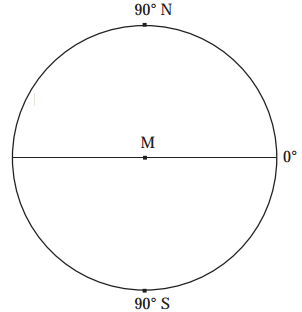
Answer:
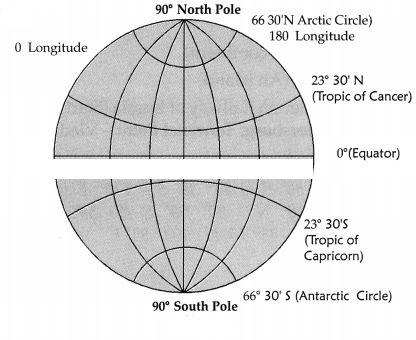
F. Write the important parallels and meridians in the following table:
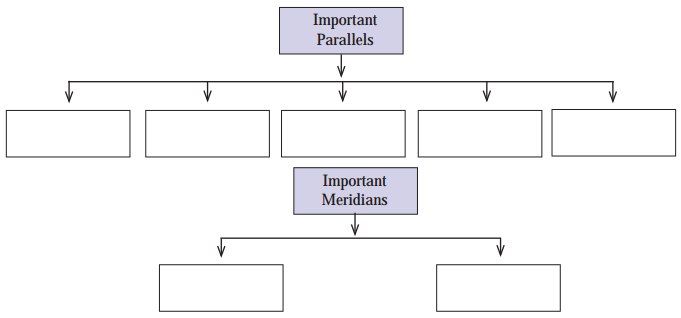
Answer:
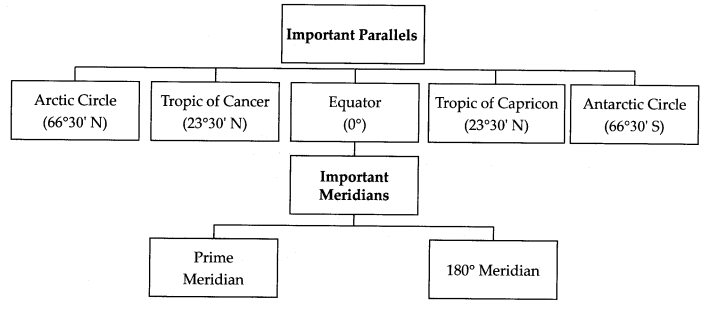
Class 6 Geography Chapter 2 Let us Use the Graticule InText Questions and Answers
Make friends with the globe!
Observe the globe and answer the following questions.

Question 1.
What are the horizontal lines on the globe called?
Answer:
The horizontal lines on the globe are called latitudes.

Question 2.
List the continents and oceans through which the equator passes.
Answer:
Continents – Africa, South America, Asia Oceans – Pacific, Atlantic and Indian
Question 3.
Encircle the intersection of 0° meridian and 0° parallel on the globe.
Answer:
Students may attempt this question of their own.
Question 4.
Which ocean is spread in all the four hemispheres?
Answer:
Pacific Ocean
Question 5.
Which continent is spread in all the four hemispheres?
Answer:
The continent of Africa
Question 6.
At which two parallels do all the meridians converge?
Answer:
90°N and 90°S parallels.
State the Importance of the following:
Question 1.
Prime Meridian
Answer:
The main purpose is to fix the global standard time and co-ordinate the standard times of different countries.
Question 2.
180° Meridian
Answer:
The International Date Line is marked with reference to this meridian.
Question 3.
Great Circles
Answer:
Great Circles are used for finding the minimum distance between any two places on the surface of the earth.

Let us use the graticule:
Answer the following questions about the location and extent with the help of figure page 11 of your textbook.
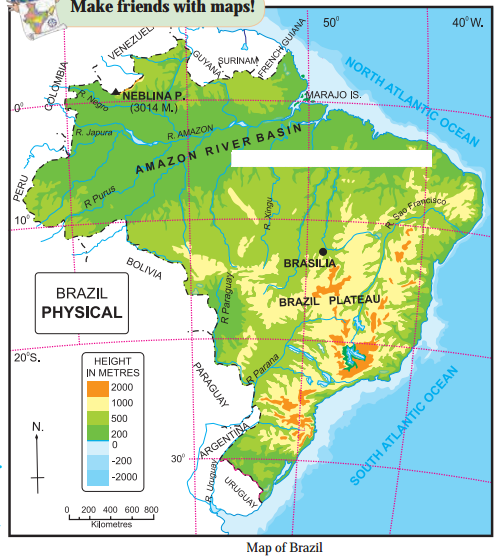
Question 1.
Which latitude and longitude define the location of the capital of Brazil- Brasilia?
Answer:
13°S latitude and 48°W longitude.
Question 2.
What would be the longitudinal extent of Brazil that spreads from 5° 15′ N to 33° 45′ S latitude?
Answer:
Longitudinal extent would be 34° 47’W to 73° 59’W.
Question 3.
In which hemispheres does Brazil extend in the north-south direction?
Answer:
Brazil extends in the both northern and southern hemispheres.

Question 4.
In which hemisphere does Brazil extend in the east-west direction?
Answer:
Brazil extends in the Western Hemisphere.
Question 5.
Which parallels and meridians should be used to describe the extend of River Sao Francisco?
Answer:
River Sao Francisco has its source at 40° 04′ W/ 20° 02’S and terminal point at 37°W/10°S.
Question 6.
Describe the location of Marajo Island using the graticule.
Answer:
Using the Graticules, the location of Marajo island is 0.4°N and 51°W.
Think a little!
Question 1.
Find on the globe, the meridians opposite to the ones mentioned below:
90°E, 170°W, 30°E, 20°W
Answer:
- 90°E – 90°W
- 170°W – 10°E
- 30°E – 150°W
- 20°W – 160°E
Think a little!
Question 1.
Which important parallel passes through India?
Answer:
Tropic of Cancer (23° 30′ N)
Question 2.
Which areas do not get perpendicular rays?
Answer:
Areas to the North of Tropic of Cancer (till Jammu and Kashmir).
Question 3.
Which region receives perpendicular ray on two days in a year?
Answer:
The region to the south of Tropic of Cancer (till Kaniyakumari).
Use your brain power!
Question 1.
In what direction should an aeroplane fly in order to cover the shortest distance between Kolkata and Chicago?
Answer:
To cover the shortest distance between Kolkata and Chicago, the aeroplane should move north west via Delhi.
Class 6 Geography Chapter 2 Let us Use the Graticule Additional Important Questions and Answers
Fill in the blanks:
Question 1.
______ is known as the smallest country in the world.
Answer:
Vatican City
Question 2.
The International Date line is marked with reference to _____ meridian.
Answer:
180°

Question 3.
The Prime Meridian is known as ________.
Answer:
Greenwich Meridian
Question 4.
Global Standard Time is known as ______.
Answer:
Greenwich Mean Time
Question 5.
Variation in the intensity of sunlight leads to regional diversity in ____ and ______.
Answer:
plant, animal life
Question 6.
Different temperature zones give rise to ______ belts.
Answer:
pressure
Question 7.
The 180° meridian lies opposite to the _______.
Answer:
Prime Meridian
Question 8.
The equator as well as all pairs of opposite meridians form ______.
Answer:
Great Circles
Question 9.
Due to the ______ and _______ of sunlight, different temperature zones are formed on the earth.
Answer:
duration, intensity
Question 10.
All places between 23° 30′ north and south of equator receives _______ rays on two days in a year.
Answer:
perpendicular
Match the pairs correctly:
Question 1.
| A (Latitudes) | B (Names) |
| (1)23°30’N | (a) Antarctic Circle |
| (2) 23°30′ S | (b) Tropic of Capricorn |
| (3)66°30’N | (c) Tropic of Cancer |
| (4) 66°30′ S | (d) Arctic Circle |
| (e) Great Circle | |
| (f) Prime Meridian |
Answer:
1 – c
2 – b
3 – d
4 – a

Complete the following sentence:
Question 1.
While describing the location of a place, we need to consider _______.
Answer:
only one parallel and one meridian
Question 2.
For describing the extent of a region, we need to consider _________.
Answer:
two parallels and two meridians at the extreme ends of the region
Question 3.
For describing the extent of linear features like a river or road we need to consider ______.
Answer:
the latitudes and longitude of their terminal points
Question 4.
All places between 23°30′ N and S of the ! equator receive perpendicular rays _____.
Answer:
on two days in a year
Question 5.
Depending on the seasons, daytime can be greater than 24 hours in areas between ________.
Answer:
the polar circles and the poles
Question 6.
All places between 23° 30′ N and South of equator ______ rays on two days in a year.
Answer:
receive perpendicular
Answer the following questions in one sentence:
Question 1.
What are Great Circles used for?
Answer:
Great Circles are used for finding the minimum distance between any two places on the surface of the earth.
Question 2.
Where is Vatican City located?
Answer:
Vatican City is the smallest country in the world located within Italy on the Italian peninsula.

Question 3.
Why is the Prime Meridian considered an important meridian?
Answer:
The prime meridian is an important meridian because its main purpose is to fix the global standard time and co-ordinate the standard times of different countries.